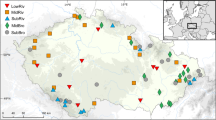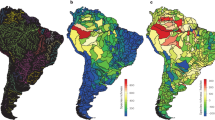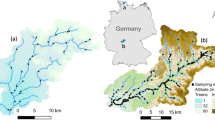Abstract
Alpine river biodiversity around the world is under threat from glacier retreat driven by rapid warming, yet our ability to predict the future distributions of specialist cold-water species is currently limited. Here we link future glacier projections, hydrological routing methods and species distribution models to quantify the changing influence of glaciers on population distributions of 15 alpine river invertebrate species across the entire European Alps, from 2020 to 2100. Glacial influence on rivers is projected to decrease steadily, with river networks expanding into higher elevations at a rate of 1% per decade. Species are projected to undergo upstream distribution shifts where glaciers persist but become functionally extinct where glaciers disappear completely. Several alpine catchments are predicted to offer climate refugia for cold-water specialists. However, present-day protected area networks provide relatively poor coverage of these future refugia, suggesting that alpine conservation strategies must change to accommodate the future effects of global warming.
This is a preview of subscription content, access via your institution
Access options
Access Nature and 54 other Nature Portfolio journals
Get Nature+, our best-value online-access subscription
$29.99 / 30 days
cancel any time
Subscribe to this journal
Receive 12 digital issues and online access to articles
$119.00 per year
only $9.92 per issue
Buy this article
- Purchase on Springer Link
- Instant access to full article PDF
Prices may be subject to local taxes which are calculated during checkout





Similar content being viewed by others
Code availability
Code is available in the supplementary material.
References
Scheffers, B. R. et al. The broad footprint of climate change from genes to biomes to people. Science 354, aaf7671 (2016).
Brondizio, E. S., Settele, J., Díaz, S. & Ngo, H. T. Global Assessment Report on Biodiversity and Ecosystem Services of the Intergovernmental Science–Policy Platform on Biodiversity and Ecosystem Services. https://doi.org/10.5281/ZENODO.6417333 (IPBES, 2019).
Scheffers, B. R. & Pecl, G. Persecuting, protecting or ignoring biodiversity under climate change. Nat. Clim. Chang. 9, 581–586 (2019).
Hock, R. et al. High Mountain Areas: IPCC Special Report on the Ocean and Cryosphere in a Changing Climate (Intergovernmental Panel on Climate Change, 2019).
Brown, L. E. et al. Functional diversity and community assembly of river invertebrates show globally consistent responses to decreasing glacier cover. Nat. Ecol. Evol. 2, 325–333 (2017).
Shugar, D. H. et al. River piracy and drainage basin reorganization led by climate-driven glacier retreat. Nat. Geosci. 10, 370–375 (2017).
Milner, A. M. et al. Glacier shrinkage driving global changes in downstream systems. Proc. Natl Acad. Sci. USA 114, 9770–9778 (2017).
Giersch, J. J., Hotaling, S., Kovach, R. P., Jones, L. A. & Muhlfeld, C. C. Climate-induced glacier and snow loss imperils alpine stream insects. Glob. Chang. Biol. 23, 2577–2589 (2017).
Cauvy-Fraunié, S. & Dangles, O. A global synthesis of biodiversity responses to glacier retreat. Nat. Ecol. Evol. 3, 1675–1685 (2019).
Jacobsen, D., Milner, A. M., Brown, L. E. & Dangles, O. Biodiversity under threat in glacier-fed river systems. Nat. Clim. Chang. 2, 361–364 (2012).
Muhlfeld, C. C. et al. Specialized meltwater biodiversity persists despite widespread deglaciation. Proc. Natl Acad. Sci. USA 117, 12208–12214 (2020).
Pitman, K. J. et al. Glacier retreat creating new Pacific salmon habitat in western North America. Nat. Commun. 12, 6816 (2021).
Milner, A. M. et al. Evolution of a stream ecosystem in recently deglaciated terrain. Ecology 92, 1924–1935 (2011).
Brown, L. E., Hannah, D. M. & Milner, A. M. Vulnerability of alpine stream biodiversity to shrinking glaciers and snowpacks. Glob. Chang. Biol. 13, 958–966 (2007).
Fell, S. C., Carrivick, J. L., Kelly, M. G., Füreder, L. & Brown, L. E. Declining glacier cover threatens the biodiversity of alpine river diatom assemblages. Glob. Chang. Biol. 24, 5828–5840 (2018).
Finn, D. S., Räsänen, K. & Robinson, C. T. Physical and biological changes to a lengthening stream gradient following a decade of rapid glacial recession. Glob. Chang. Biol. 16, 3314–3326 (2010).
Brown, L. E. & Milner, A. M. Rapid loss of glacial ice reveals stream community assembly processes. Glob. Chang. Biol. 18, 2195–2204 (2012).
Huss, M. & Hock, R. A new model for global glacier change and sea-level rise. Front. Earth Sci. 3, 54 (2015).
Milner, A. M., Brittain, J. E., Castella, E. & Petts, G. E. Trends of macroinvertebrate community structure in glacier-fed rivers in relation to environmental conditions: a synthesis. Freshw. Biol. 46, 1833–1847 (2001).
Fell, S. C., Carrivick, J. L. & Brown, L. E. The multitrophic effects of climate change and glacier retreat in mountain rivers. Bioscience 67, 897–911 (2017).
Zekollari, H., Huss, M. & Farinotti, D. Modelling the future evolution of glaciers in the European Alps under the EURO-CORDEX RCM ensemble. Cryosphere 13, 1125–1146 (2019).
Phillips, S. J. et al. Sample selection bias and presence-only distribution models: implications for background and pseudo-absence data. Ecol. Appl. 19, 181–197 (2009).
Clappe, S., Dray, S. & Peres-Neto, P. R. Beyond neutrality: disentangling the effects of species sorting and spurious correlations in community analysis. Ecology 99, 1737–1747 (2018).
Valavi, R., Elith, J., Lahoz-Monfort, J. J. & Guillera-Arroita, G. blockCV: an R package for generating spatially or environmentally separated folds for k-fold cross-validation of species distribution models. Methods Ecol. Evol. 10, 225–232 (2019).
Raes, N. & ter Steege, H. A null-model for significance testing of presence-only species distribution models. Ecography 30, 727–736 (2007).
Desquilbet, M. et al. Comment on ‘Meta-analysis reveals declines in terrestrial but increases in freshwater insect abundances’. Science 370, eabd8947 (2020).
Rossaro, B., Montagna, M. & Lencioni, V. Environmental traits affect chironomid communities in glacial areas of the Southern Alps: evidence from a long-lasting case study. Insect Conserv. Divers. 9, 192–201 (2016).
Losapio, G. et al. The consequences of glacier retreat are uneven between plant species. Front. Ecol. Evol. 8, 520 (2021).
Hotaling, S. et al. Demographic modelling reveals a history of divergence with gene flow for a glacially tied stonefly in a changing post-Pleistocene landscape. J. Biogeogr. 45, 304–317 (2018).
Finn, D. S., Theobald, D. M., Black, W. C. IV & Poff, N. L. Spatial population genetic structure and limited dispersal in a Rocky Mountain alpine stream insect. Mol. Ecol. 15, 3553–3566 (2006).
Brighenti, S. et al. Rock glaciers and related cold rocky landforms: overlooked climate refugia for mountain biodiversity. Glob. Chang. Biol. 27, 1504–1517 (2021).
Dornelas, M. & Daskalova, G. N. Nuanced changes in insect abundance. Science 368, 368–369 (2020).
Ashcroft, M. B. Identifying refugia from climate change. J. Biogeogr. 37, 1407–1413 (2010).
Brambilla, M. et al. Identifying climate refugia for high-elevation alpine birds under current climate warming predictions. Glob. Chang. Biol. 28, 4276–4291 (2022).
Vittoz, P. et al. Climate change impacts on biodiversity in Switzerland: a review. J. Nat. Conserv. 21, 154–162 (2013).
Schai-Braun, S. C., Jenny, H., Ruf, T. & Hackländer, K. Temperature increase and frost decrease driving upslope elevational range shifts in alpine grouse and hares. Glob. Chang. Biol. 27, 6602–6614 (2021).
Khamis, K., Brown, L. E., Hannah, D. M. & Milner, A. M. Glacier–groundwater stress gradients control alpine river biodiversity. Ecohydrology 9, 1263–1275 (2016).
Farinotti, D., Pistocchi, A. & Huss, M. From dwindling ice to headwater lakes: could dams replace glaciers in the European Alps? Environ. Res. Lett. 11, 054022 (2016).
Hao, T., Elith, J., Lahoz-Monfort, J. J., Guillera-Arroita, G. & Hao, T. Testing whether ensemble modelling is advantageous for maximising predictive performance of species distribution models. Ecography 43, 549–558 (2020).
Kaky, E., Nolan, V., Alatawi, A. & Gilbert, F. A comparison between ensemble and MaxEnt species distribution modelling approaches for conservation: a case study with Egyptian medicinal plants. Ecol. Inform. 60, 101150 (2020).
Thompson, P. L. et al. A process-based metacommunity framework linking local and regional scale community ecology. Ecol. Lett. 23, 1314–1329 (2020).
Khamis, K., Brown, L. E., Hannah, D. M. & Milner, A. M. Experimental evidence that predator range expansion modifies alpine stream community structure. Freshw. Sci. 34, 66–80 (2015).
Clitherow, L. R., Carrivick, J. L. & Brown, L. E. Food web structure in a harsh glacier-fed river. PLoS ONE 8, e60899 (2013).
Niedrist, G. H. & Füreder, L. Trophic ecology of alpine stream invertebrates: current status and future research needs. Freshw. Sci. 36, 466–478 (2017).
Blowes, S. A. et al. The geography of biodiversity change in marine and terrestrial assemblages. Science 366, 339–345 (2019).
Fell, S. C. et al. Fungal decomposition of river organic matter accelerated by decreasing glacier cover. Nat. Clim. Chang. 11, 349–353 (2021).
Kohler, T. J. et al. Glacier shrinkage will accelerate downstream decomposition of organic matter and alters microbiome structure and function. Glob. Chang. Biol. 28, 3846–3859 (2022).
GLIMS: Global Land Ice Measurements from Space; https://www.glims.org/RGI/ (2017).
Hersbach, H. et al. The ERA5 global reanalysis. Q. J. R. Meteorol. Soc. 146, 1999–2049 (2020).
Eyring, V. et al. Overview of the Coupled Model Intercomparison Project Phase 6 (CMIP6) experimental design and organization. Geosci. Model Dev. 9, 1937–1958 (2016).
Meinshausen, M. et al. The shared socio-economic pathway (SSP) greenhouse gas concentrations and their extensions to 2500. Geosci. Model Dev. 13, 3571–3605 (2020).
Ou, Y. N. et al. Can updated climate pledges limit warming well below 2 °C?; Increased ambition and implementation are essential. Science 374, 693–695 (2021).
Marzeion, B. et al. Partitioning the uncertainty of ensemble projections of global glacier mass change. Earth’s Futur. 8, e2019EF001470 (2020).
Tarboton, D. Terrain Analysis Using Digital Elevation Models (TauDEM)(2008); https://hydrology.usu.edu/taudem/taudem3.1/
Carrivick, J., Heckmann, T., Fischer, M. & Davies, B. in Geomorphology of Proglacial Systems. Geography of the Physical Environment (eds. Heckmann, T. & Morche, D.) 43–57 (Springer, 2019); https://doi.org/10.1007/978-3-319-94184-4_3
Carrivick, J. L., Heckmann, T., Turner, A. & Fischer, M. An assessment of landform composition and functioning with the first proglacial systems dataset of the central European Alps. Geomorphology 321, 117–128 (2018).
Farinotti, D. et al. A consensus estimate for the ice thickness distribution of all glaciers on Earth. Nat. Geosci. 12, 168–173 (2019).
Linke, S. et al. Global hydro-environmental sub-basin and river reach characteristics at high spatial resolution. Sci. Data 6, 283 (2019).
Slope Derived from the Digital Elevation Model over Europe from the GSGRDA Project (EU-DEM-PRE Slope, Resolution 25 m); https://sdi.eea.europa.eu/catalogue/srv/api/records/b0f63ca4-a269-4769-b384-5eedd64a7522 (2012).
Hengl, T. et al. SoilGrids250m: global gridded soil information based on machine learning. PLoS ONE 12, e0169748 (2017).
Valavi, R., Guillera-Arroita, G., Lahoz-Monfort, J. J. & Elith, J. Predictive performance of presence-only species distribution models: a benchmark study with reproducible code. Ecol. Monogr. 92, e01486 (2022).
Araújo, M. B. et al. Standards for distribution models in biodiversity assessments. Sci. Adv. 5, 4858–4874 (2019).
van Proosdij, A. S. J., Sosef, M. S. M., Wieringa, J. J. & Raes, N. Minimum required number of specimen records to develop accurate species distribution models. Ecography 39, 542–552 (2016).
Soultan, A. & Safi, K. The interplay of various sources of noise on reliability of species distribution models hinges on ecological specialisation. PLoS ONE 12, e0187906 (2017).
Thuiller, W., Lafourcade, B., Engler, R. & Araújo, M. B. BIOMOD—a platform for ensemble forecasting of species distributions. Ecography 32, 369–373 (2009).
Acknowledgements
The collection of data modelled in this study was funded by multiple organizations. A UK Natural Environment Research Council (NERC) Scholarship (number NE/L002574/1) was awarded to S.C.F. Additional financial support for laboratory overheads was provided to S.C.F. by the River Basin Processes and Management Cluster, School of Geography, University of Leeds. Support for L.E.B. was provided by the Royal Society (International Outgoing grant 2006/R4) and for L.E.B. and J.L.C. by the Royal Geographical Society-Institute of British Geographers with the Royal Institute of Chartered Surveyors (GFG 39/08). Financial support for V.L. was provided by the European Union Environment and Climate Programme, contract number ENV4-CT95-0164/1996, the Autonomous Province of Trento (Italy) (grant 1060/2001; grant 3402/2002) and the protected areas Adamello Brenta Nature Park and Stelvio National Park. Sampling in the French Alps by S.C.-F. has been supported by the Agence Alpes de l’Eau Rhône Méditerranée Corse (grant 722 2017 024), the Région Auvergne-Rhône-Alpes (BERGER project, grant P089O002), the Observatoire des Sciences de l’Univers de Grenoble, the LTSER Zone Atelier Bassin du Rhône, and the protected areas Vanoise National Park and Aiguilles Rouges nature reserve. Financial support for the University of Geneva (E.C.) was provided by the Académie Suisse des Sciences Naturelles, the Société Murithienne, the Société Académique of Geneva and the French Embassy in Switzerland. Partial funding for this project was through an EAWAG Action Field Grant ‘Aquatic Biodiversity in Rapidly Changing Alpine Landscapes’ (C.R.). We are grateful to multiple people, too numerous to list, who have assisted with the collection, identification and analysis of alpine river datasets used in this study. However, special thanks go to B. Maiolini, promoter of research on glacial streams in Italy in the late 1990s; B. Lods-Crozet, who provided invaluable taxonomic expertise about Chironomidae in some of the Rhône basin sites; B. Launay and M. Forcellini for their taxonomic expertise (especially for Ephemeroptera, Plecoptera and Trichoptera); and J. Becquet for significant support in the lab.
Author information
Authors and Affiliations
Contributions
M.A.W., J.L.C. and L.E.B. led the study and the writing of the manuscript. J.L.C. and M.H. performed the glacial and hydrological modelling. M.A.W. performed the species distribution modelling and all statistical tests. M.A.W., J.L.C., L.E.B. and W.J. designed the methodology. E.C., C.I., S.C-F., S.C.F., L.F., V.L., C.R. and L.E.B. collected field data and acquired funding for their collection. All authors contributed to review and editing.
Corresponding author
Ethics declarations
Competing interests
The authors declare no competing interests.
Peer review
Peer review information
Nature Ecology & Evolution thanks Scott Hotaling, Wilfried Thuiller and Rocco Tiberti for their contribution to the peer review of this work. Peer reviewer reports are available.
Additional information
Publisher’s note Springer Nature remains neutral with regard to jurisdictional claims in published maps and institutional affiliations.
Extended data
Extended Data Fig. 1 Projected catchment level environmental changes in selected decades.
Left column shows baseline sub-catchment means of glacial influence (GI), contributing area (CA), pH and slope in 2020. Middle and left columns show changes in 2060 and 2100, respectively, as a percentage of 2020 sub-catchment means. Sub-catchments with no glacial influence under the baseline condition are shown in grey. *Slope is a dimensionless variable.
Extended Data Fig. 2 Distributions of environmental conditions at the river segment level.
Rows show probability densities for each major river basin. Columns show data for contributing area (CA), pH and slope respectively. White marks show the distribution of each variable for biological samples. *Slope is a dimensionless variable.
Extended Data Fig. 3 Projected catchment level environmental conditions in selected decades.
Rows show sub-catchment means of glacial influence (GI), contributing area (CA), pH and slope respectively. Columns show conditions in 2020, 2060 and 2100 respectively. Sub-catchments with no glacial influence under the baseline condition (2020) are shown in grey. *Slope is a dimensionless variable.
Extended Data Fig. 4 Response curves for 15 alpine invertebrate species.
Rows show predictions from the best performing species distribution model for each species. Columns show response curves for each environmental variable, including glacial influence (GI), contributing area (CA), pH and slope. Curves for each variable were generated from models whilst holding all other variables at their mean values from the biological dataset. Colours correspond to the identity of the best performing model for each species, including Artificial Neural Network (ANN), Generalized Additive Model (GAM), Generalized Linear Model (GLM), Maximum Entropy (MAXENT) and an ensemble mean (‘mean’). Solid lines and dashed lines respectively show curves within and outside of the 99% confidence limits of the background environmental data. Shaded areas show 95% confidence intervals from cross-validation. Black marks at the upper edge of each panel show the distribution of the corresponding variable where the species was recorded as present. *Slope is a dimensionless variable.
Extended Data Fig. 5 Predicted change in suitable habitat area for 15 alpine invertebrate species.
Panels for each species show the change in suitability-weighted habitat area per decade relative to a 2020 baseline within major river basins. Lines denote the mean of model predictions and shaded areas show 95% confidence intervals from cross-validation.
Extended Data Fig. 6 Predicted habitat elevation changes.
Distributions of habitat suitability by elevation band across selected decades by major river basin (columns) and species (rows). Boxplots show the median (centre line), interquartile range (box limits) and 1.5 x interquartile range (whiskers). Sample sizes (number of river segments) for the Danube, Po/Adige, Rhine and Rhône basins respectively are n = 2683, n = 2797, n = 1726 and n = 3418 in 2020, n = 2775, n = 2831, n = 2019 and n = 3607 in 2060, and n = 2755, n = 2851, n = 2102 and n = 3609 in 2100.
Extended Data Fig. 7 Species distribution model performance.
Performance metrics of the best performing model for each species, including area under the curve (AUC) of the receiver operating characteristic and mean absolute error (MAE) on the out-of-sample (‘test’) data and training data. Colours correspond to the identity of the best performing model for each species, including Artificial Neural Network (ANN), Generalized Additive Model (GAM), Generalized Linear Model (GLM), Maximum Entropy (MAXENT) and an ensemble mean (‘mean’). The left panel shows the distribution of AUC values from the null model (upper, closed distribution) and from training folds (lower, open distribution). Species shown in ascending order of glacial influence optima. Boxplots show the median (centre line), interquartile range (box limits) and 1.5 x interquartile range (whiskers). P-values shown from a one-sided bootstrap hypothesis test. Sample sizes (n) denote the number of model folds.
Supplementary information
Supplementary Information
Supplementary Notes 1 and 2, Supplementary Figures 1–62 and Supplementary Tables 1 and 2.
Supplementary Data 1
Supplementary Data 1 Data submitted for species distribution modelling.
Rights and permissions
Springer Nature or its licensor (e.g. a society or other partner) holds exclusive rights to this article under a publishing agreement with the author(s) or other rightsholder(s); author self-archiving of the accepted manuscript version of this article is solely governed by the terms of such publishing agreement and applicable law.
About this article
Cite this article
Wilkes, M.A., Carrivick, J.L., Castella, E. et al. Glacier retreat reorganizes river habitats leaving refugia for Alpine invertebrate biodiversity poorly protected. Nat Ecol Evol 7, 841–851 (2023). https://doi.org/10.1038/s41559-023-02061-5
Received:
Accepted:
Published:
Issue Date:
DOI: https://doi.org/10.1038/s41559-023-02061-5



